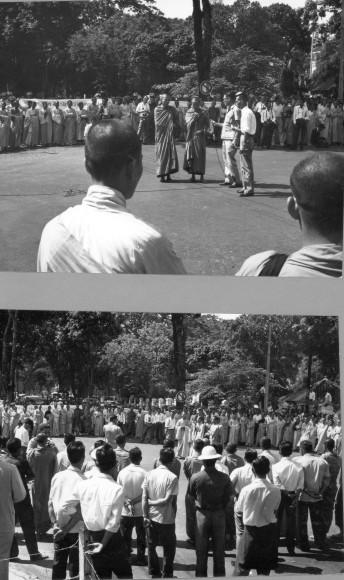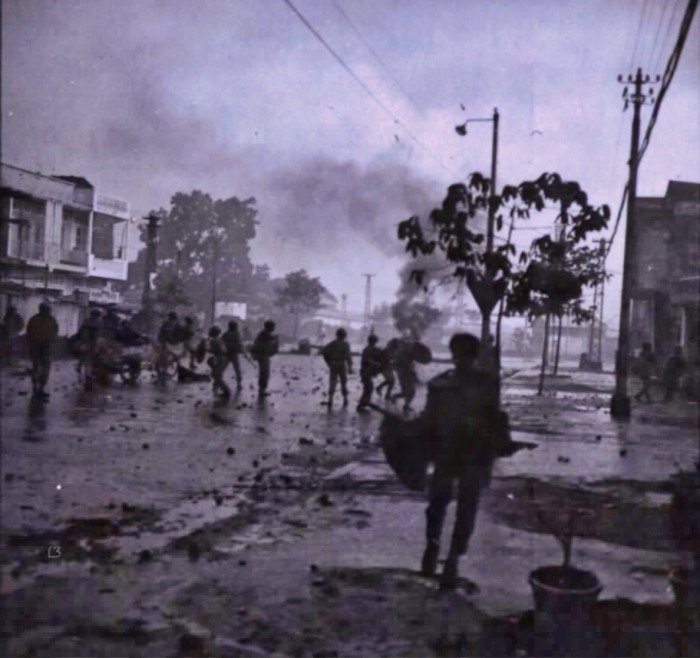
On May 4, 1963, Catholics across the Republic of Vietnam displayed a Catholic flag to mark the silver jubilee of Ngô Đình Thục’s being chosen as the first Vietnamese Apostolic Vicar. Two days later, Ngô Đình Thục’s younger brother, the President of the Republic of Việt Nam Ngô Đình Diệm, sent a telegram indicating that displays of religious flags were to be banned. On May 8, celebrations in honor of Gautama Buddha’s birth were held. In Huế, Buddhist flags were displayed prominently, leading to the Army of the Republic of Vietnam’s tearing them down. Subsequently, more than three thousand Buddhists marched to a local radio station in Huế. ARVN troops initially used tear gas, but then fired on the demonstrators, killing eight people. 1
Although Ngô Đình Diệm met with Buddhist leaders in May and offered to conciliate on the flag issue and to reaffirm his commitment to religious freedom, these gestures were insufficient in the eyes of Buddhists for two reasons: the government did not accept full responsibility for the killings, and they were slow to implement the reforms that had been promised. By the summer of 1963, protracted political actions by Buddhist monks and laypeople who supported them (particularly college students), such as hunger strikes and protests, became the norm, not only in Huế but also around the country. The most famous event of this wave of protests was the immolation of Thích Quảng Đức at a major Saigon intersection on June 11. On September 1, the man who had increasingly become the face of the protests, Thích Trí Quang, and several other Buddhist leaders, sought, and were given, asylum within the United States Embassy in Saigon. Though martial law was lifted by mid-September and the Diệm administration sought to placate both Buddhists and an increasingly restive patron in the United States by holding a relatively free national assembly election in late September, the die was cast. On November 1, a group of generals with the tacit support of the United States and with good relations with Buddhist leadership overthrew Diệm in a coup, and on November 4, Thích Trí Quang left the United States Embassy triumphant. By 1964, Buddhist leaders, cognizant of their new political authority and wary that future events in Vietnam might lead to their further persecution, sought to formalize the unity that the Buddhist crisis of 1963 had created by forming the United Buddhist Sangha (UBC), which brought together the majority of formerly quarreling sects that had been historically been divided by both region and ideology. 2
This article is an initial report on my current research which considers the ways in which the leaders of the Buddhist crisis, particularly in Huế, sought to cultivate continued support for their positions, maintain unity among Buddhists, and advocate for continued political strength in the aftermath of the Buddhist crisis of 1963, through an analysis of the articles published in Liên Hoa Nguyệt San (Lotus Monthly), which had by the early 1960s become a major catalyst of lay Buddhist opinion, not only in central Vietnam but throughout the Republic. It will argue that by positioning itself as the mouthpiece of the UBC and by giving a substantial platform for Thích Trí Quang to advocate that the Buddhist movement should continue and sustain its political agitation, Liên Hoa Nguyệt San helped galvanize the public toward Thích Trí Quang’s views and set the stage for the later events of Buddhist actions in 1965-66 and throughout the rest of the Republic period.

Photo: Douglas Pike Photograph Collection, Vietnam Center and Sam Johnson Vietnam Archive, Texas Tech University
The Mouthpiece: Liên Hoa Nguyệt San
Back in 1955, the Buddhist Sangha of Central Vietnam (Giáo hội Tăng già Trung Việt) had decided to publish a series of works called the “Lotus Series” whose purpose was to make Buddhism more accessible. This effort was to be led by the Nun Thích nữ Diệu Không (1905-1997). 3 In November 1955, a special meeting of the Sangha of Central Vietnam was held in which Diệu Không turned in several short articles, and it was decided to publish them in what would become a monthly journal, with the first issue coming out at Tết in the year of the monkey (1956). The Sangha assigned Thích Đôn Hậu of Linh Mụ pagoda (1905-1992) as the chair, Venerable Thích Đức Tâm as the editor. Thích nữ Diệu Không stayed on with the publication as the manager.
Over time, Lotus Monthly expanded from its base in Central Vietnam to become a prominent mouthpiece for Buddhists across the Republic. By the early 1960s, its contents were widely circulated and shared, and it became “the voice of the sangha in the entire territory south of the 17th parallel.” 4 As it did, it became an influential conduit for information on the 1963 Buddhist crisis and the formation of the Unified Buddhist Church in Vietnam, which was a logical development since the events of 1963 were centered in Huế, and several of the major participants in those events, from Thích Trí Quang to Thích Đôn Hậu, were affiliated with the journal or were frequent contributors. Because of this, although the events of the Buddhist crisis shut down the publication of Lotus Monthly from the spring through the fall of 1963, it became a central place, in late 1963 and throughout 1964, to understand the events of the Buddhist crisis and also to comprehend the trajectory that led from the protests against the Ngô Đình Diệm government in 1963 to the protests for democratization and a US withdrawal in 1965-1966.
Lotus Monthly, The Buddhist Crisis, and the UBC, 1963-64
Though the censorship and repression that came along with the Buddhist crisis of 1963 forced the temporary shuttering of Lotus Monthly, the coup d’etat of November 1963 produced conditions favorable to the resuming of the publication. The November 1963 issue appears to have been rushed to publication, with considerable misprints and pages missing from the few copies that are available worldwide. The issue started with an editorial, presumably written by Thích Đôn Hậu and Thích Đức Tâm, explaining what they saw as the proper role of Lotus Monthly given the events of 1963. They explained that between April and September, Vietnamese Buddhists had been “dragged into a storm of fear.” After the coup, however, “the rain has stopped, and the wind has abated, in our country, for the good of all Vietnamese people, Buddhist or not. Everyone feels relieved and calmed.” Despite the many Buddhists and laypeople who had been “beaten or imprisoned, all of us feel as if the time for relief has arrived.” While he army had acted to end the crisis of the previous six months, but it was the “many monks and nuns, lay Buddhists, professors, university students, and high school students who secretly or openly sacrificed themselves of the righteous cause” that needed to be remembered. Vietnamese people could not forget that “seven monks and nuns made themselves into torches to light the way for the fight against darkness” and that “many Buddhist students have fallen under the fragments of grenades or have been trampled under the wheels of tanks” and that “many professors and students” were also jailed and lost their lives. The spirit of Buddhists, and the responsibility of journals such as Lotus Monthly, was to honor their memory.

Lotus Monthly had taken political stands in the past. For example, they had roundly criticized the Chinese Communist Party’s treatment of the Dalai Lama and other Tibetan Buddhists during their forced repatriation to India in 1959. 5 But following the shocking events of 1963, this kind of overtly political commentary became much more the norm. Accordingly, when the UBC was founded in January 1964, Lotus Monthly became one of the main conduits for the dissemination of its central message.
The January 1964 issue started with an article that made clear that the UBC and the Viện Hóa Đạo specifically intended to actualize the promise of a united Buddhist front through the medium of Lotus Monthly. The authors made clear that Lotus Monthly should be used by readers as a conduit to the UBC. 6 This prominence was only underscored by the second article in the January 1964 issue of the journal, which offered greetings for the new year from the Principal of the Viện Hóa Đạo, Thích Tâm Châu. His message, was that despite the carnage of 1963, Vietnamese Buddhists had gained a platform to “disseminate out the truth of Buddhism.” To continue this historic path, Buddhists needed to act “with patience, compassion, and good will toward all Buddhists and sentient beings” in order to “make the darkness dissipate.” And they needed to maintain unity and determination: “Although hungry ghosts might barricade the streets, block our way, shoot, imprison, and kill us, we will not flinch.” 7 To continue to be vigilant against authoritarian actions, Vietnamese Buddhists to stand behind the agenda of the Viện Hóa Đạo and the UBC.
The Prominence of Thích Trí Quang’s Agenda
The most significant other article in the first edition of the 1964 Lotus Monthly was an extended article by the leader of the 1963 protests, Thích Trí Quang, which would continue to be published in segments in each issue of Lotus Monthly for much of 1964. This essay, entitled “Cuộc Vận Động của Phật Giáo Việt Nam” (The Vietnamese Buddhist Movement), provided both a history of the developments of 1963 and an agenda for the movement going forward.
Thích Trí Quang argued that the sangha and laypeople were primed to take collective action to produce critical and positive political change in the world, and they had also been able to take advantage of the sudden international spotlight placed on Vietnam’s plight in 1963 to gather the sympathy of people from around the world. In this environment, Thích Trí Quang urged the movement not to squander the political capital that they had earned: “we can use this power to make our authority known and use our suffering to effect policy change.” Because of this, he urged Buddhists to continue this political action to make sure that “rogue policies” were not re-implemented, and to remember that “the change in policy that we have prayed for in our campaign will influence the aspirations of the people a great deal.” The need to be vigilant in maintaining the gains that Buddhists had achieved in 1963, and knowing that more could be done in the future, will only “increase our determination.” 8

Conclusion
By January of 1964, two developments in the life of Lotus Monthly had come to fruition. The first was that it had become a de facto mouthpiece for the dissemination of information about the UBC, not only in central Vietnam but throughout the Republic of Vietnam. The second was that it had become a mouthpiece for the political advocacy of the UBC. Although Lotus Monthly had not shied away from topics of contemporary political relevance before, by 1964, this political advocacy had taken on a new level of importance and urgency.
Moreover, Lotus Monthly began increasingly to feature the opinions of Thích Trí Quang, whose extended essay on the Buddhist movement began to be published in the November 1963 and continued through most of 1964. Previously, Lotus Monthly had featured the opinions of a more diverse group of people, but by 1964, the editors of Lotus Monthly, perhaps radicalized by the events in Huế of the previous year, decided to focus on Trí Quang’s brand of political activism. Lotus Monthly’s strong circulation across the Republic allowed this political message to remain active even through the multiple political changes of 1963-1965 and the escalation of American involvement in Vietnam. A straight line can be drawn between these developments and Lotus Monthly’s editorial calling for peaceful reconciliation in January of 1966, which was one of many first steps leading to the Buddhist crisis in the spring of 1966. 9 That political crisis brought an end to Lotus Monthly, which did not survive it, but this journal played a critical role in maintaining Thích Trí Quang’s particular sense of political activism between the events of 1963 and 1966.
Wynn Gadkar-Wilcox
Western Connecticut State University
Notes:
- For detailed accounts of these events, see Edward Miller, “Religious Revival and Nation Building: Reinterpreting the 1963 ‘Buddhist crisis’ in South Vietnam,” Modern Asian Studies 49:6 (November 2015): 1926; and Charles A. A. Joiner, “South Vietnam’s Buddhist Crisis: Organization for Charity, Dissidence, and Unity,” Asian Survey 4, no. 7 (July 1964): 915-16. ↩
- Robert Topmiller, The Lotus Unleashed: The Buddhist Peace Movement in South Vietnam, 1964-66 (Lexington, KY: University Press of Kentucky, 2002), 4-6. ↩
- Vũ Trung Kiên, “Ni Trưởng Thích Nữ Diệu Không: Một kỳ nữ của Việt Nam trong thế kỷ XX,” Thư viện hoa sen (July 9, 2020). Accessed December 21, 2021. https://thuvienhoasen.org/a34224/ni-truong-thich-nu-dieu-khong-mot-ky-nu-cua-viet-nam-trong-the-ky-20 ↩
- Phi-Vân Nguyen, “A Secular State for a Religious Nation: The Republic of Vietnam and Religious Nationalism, 1946-1963,” Journal of Asian Studies 77:3 (August 2018): 758. ↩
- Phi-Vân Nguyen, “A Secular State for a Religious Nation,” 759-760. ↩
- Ibid, 2. ↩
- Thích Tâm Châu, “Thông bạch đầu xuân của thượng tọa Viện Trưởng Viện Hóa Đạo Giáo hội Phật Giáo Việt Nam Thống Nhất,” [Early spring message of the Venerable Principal of the Vien Hoa Dao of the Unified Buddhist Sangha of Vietnam], Liên-hoa Nguyệt San 10:1 (January 1964): 3. ↩
- Ibid, 12. ↩
- Liên Hoa, “Vắn đề hòa bình,” [The Issue of Peace], Liên Hoa Nguyệt San 11:12 (January 1966): 6. ↩
